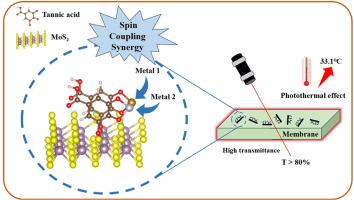单宁酸接枝二硫化钼光热性能的双金属协同增强
IF 4.2
3区 材料科学
Q2 MATERIALS SCIENCE, MULTIDISCIPLINARY
引用次数: 0
摘要
系统地研究了单宁酸接枝二硫化钼(TA-MoS2)中双金属络合的光学和光热性质。采用超声辅助油浴法制备了TA-MoS2纳米片。然后,在TA-MoS2中引入过渡金属(TM = Fe, Co, Ni, Cu和Zn)。TM/TA-MoS2的光学吸收系数随着TM价电子的减少而增加。在Fe/TA-MoS2的基础上,引入其他TMs形成双金属Fe- tm /TA-MoS2。高透光率的Fe-Ni /TA-MoS2膜在不同的组分中表现出最佳的光热性能。重要的是,其最高平衡温度比原始TA-MoS2高33.1℃,透过率保持在80%以上。基于第一性原理计算,Fe-Ni /TA-MoS2的高光学吸收系数来源于Fe-Ni原子形成的多电子杂质带。双TMs之间协同协调效应的设计为建筑光热玻璃的发展开辟了新的途径。本文章由计算机程序翻译,如有差异,请以英文原文为准。

The bimetallic synergistic enhancement of photothermal properties in tannic acid-grafted MoS2
We systematically investigated the optical and photothermal properties of bimetallic complexation in tannic acid-grafted MoS2 (TA-MoS2). The TA-MoS2 nanosheets were synthesized via an ultrasound-assisted oil-bath method. Afterwards, transition metals (TM = Fe, Co, Ni, Cu and Zn) were introduced into TA-MoS2. The optical absorption coefficient of TM/TA-MoS2 increased with fewer valence electrons of the TM. Based on Fe/TA-MoS2, the introduction of other TMs forms bimetallic Fe-TM/TA-MoS2. The Fe–Ni/TA-MoS2 membrane with high-transmittance exhibits the optimal photothermal properties compared with the various compositions. Importantly, its highest equilibrium temperature was 33.1 °C higher than that of the pristine TA-MoS2, and the transmittance remains above 80 %. Based on first-principles calculations, the high optical absorption coefficient of Fe–Ni/TA-MoS2 originates from the multi-electron impurity bands formed by Fe–Ni atoms. The design of a synergistic coordination effect between dual TMs paves a new way for developing architectural photothermal glass.
求助全文
通过发布文献求助,成功后即可免费获取论文全文。
去求助
来源期刊

Optical Materials
工程技术-材料科学:综合
CiteScore
6.60
自引率
12.80%
发文量
1265
审稿时长
38 days
期刊介绍:
Optical Materials has an open access mirror journal Optical Materials: X, sharing the same aims and scope, editorial team, submission system and rigorous peer review.
The purpose of Optical Materials is to provide a means of communication and technology transfer between researchers who are interested in materials for potential device applications. The journal publishes original papers and review articles on the design, synthesis, characterisation and applications of optical materials.
OPTICAL MATERIALS focuses on:
• Optical Properties of Material Systems;
• The Materials Aspects of Optical Phenomena;
• The Materials Aspects of Devices and Applications.
Authors can submit separate research elements describing their data to Data in Brief and methods to Methods X.
 求助内容:
求助内容: 应助结果提醒方式:
应助结果提醒方式:


